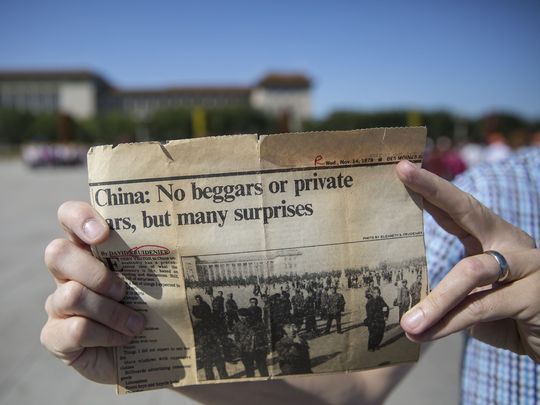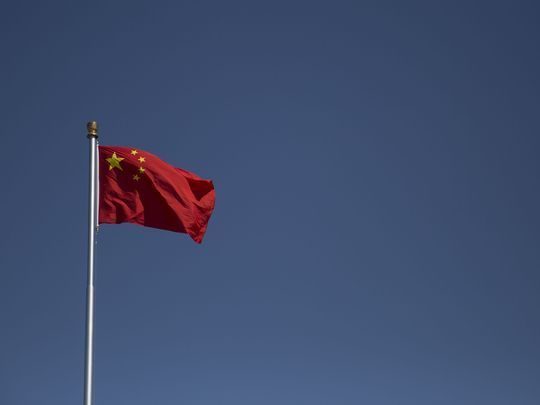BEIJING, China — We stood in Tiananmen Square — the heart of China — where on the north side, a giant portrait of Chairman Mao hangs above the entrance to the Forbidden City.
To the south, the embalmed body of the Communist nation’s founder remains on display inside a mausoleum. The scene was both familiar and a far cry from 1979, when Register Publisher David Kruidenier and his wife, Liz, traveled to China and stood in this very same spot.
That was the same year China’s Deng Xiaoping visited President Jimmy Carter in the U.S. as a prelude to China granting America full diplomatic relations.
So the Kruideniers visited a reopening China to take an exploratory firsthand peek. They published accounts of their travels that November in the Register.
Thirty-eight years later, my colleague Kelsey Kremer shot 360-degree photos and video footage of the square.
We also paid homage to one of Liz’s original photos: The Great Hall of the People that frames the western side of the square is visible in the background of the black-and-white photograph on yellowed newspaper.
I held up the brittle page in a stiff breeze so that Kelsey could juxtapose a sense of 1979 and 2017 within a single frame.
Back in 1979, the square teemed with citizens who all sported a monochromatic dress code of “blue Sun Yat-sen jackets … and trousers.”
Kruidenier reported that “Do Re Mi” from “The Sounds of Music” strangely qualified as the most popular song in China.
Certain foreign radio broadcasts were being jammed.
“I had been to India, and I had just witnessed the crowd at Living History Farms for Pope John Paul II, so I thought I was prepared for China,” Kruidenier wrote in 1979. “But the mass of humanity in both (Beijing) and Shanghai dwarfed anything I’d seen before.”
The modern Tiananmen is a colorful sea of tourists who flock here from around China and the globe.
They stream into the square in gaggles, wearing bright blazing hats and often led by a guide whose tall flag bobs its way through the modern mass of humanity.
Today, the smartphone culture is as rampant here as anywhere in the developed world. Everybody seems to be glued to blaring videos and WeChat social media as they circulate around the city.
Rather than tuning in radio signals, trying to squeeze digital data through China’s “Great Firewall” is the prevailing media hurdle.
On a morning walk earlier this week, I arrived in Tiananmen Square by accident — emerging from an alley into the throng. I was quickly swept up in a stampede toward its center.
It was about 5:30 a.m., so I should have known that the mad dash was for the patriotic viewing of the daily flag-raising ceremony at 6 a.m.
Later in the week, Kelsey and I were taken inside the Forbidden City, the vast imperial palace complex north of the square that — speaking of the Pope — dwarfs the Vatican and most other historic seats of ceremony and power.
Just strolling through the vast systematic plazas and temples of the 178-acre complex helps explain how deeply engrained deliberate process is to the cultural soul of this country.
The Kruideniers in their day were surrounded by hundreds of curious onlookers who had never before set eyes on Americans.
At this point, most of Beijing not only is used to the influx of foreigners but caters to them — though I did witness children inside the Forbidden City who were eager to pose for a photo with a young blond woman because of the novelty.
In Western media, Tiananmen tends to be mentioned in the first breath as the site of 1989's historic antigovernment protests by students.
But the square as I’ve found it this week is more of a continuously bustling sentimental gathering place than I imagined — a more concentrated National Mall with more loitering than strolling.
Kelsey and I have left Beijing for a little while to drive through the beautiful green mountains northeast of the capital on the way to a deeply symbolic new farm that I’ll write more about soon.
“On even the most advanced communes,” Kruidenier wrote in 1979, “there is little farm machinery."
As we trek into the countryside, I have a feeling that the modern rural landscape could feel nearly as different as the heart of China.

